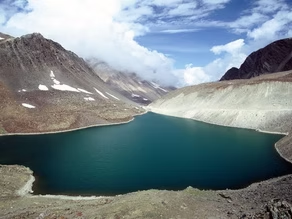The Pristine Waters of Spiti Valley

Photo by The Statesman Spiti Valley is one of the most beautiful places in India. From the peaceful monasteries to the adventurous treks, from the oh- so- tasty local food to the restaurants with a variety of cuisines, from the luscious green mountains during the summer to the breath-taking snow- covered mountains of the winters, Spiti Valley has it all. One cannot ever get over this cold desert. Each person who visits Spiti will fall in love with it and then, whatever they do, Spiti will definitely have a place in their hearts. One will only see a splendid view as far as the eyes can see. Once you visit Spiti Valley, you cannot stop gushing about it during all of your travel stories. Spiti does offer you everything on a platter. And if that wasn’t just enough, Spiti Valley has something more. You may ask, will this place ever stop taking us by surprise? And the answer to it will probably be forever unknown. But what was that something more, you might wonder? The interesting thing is its lakes. Spiti Valley has numerous lakes that one should see when in Spiti Valley. So, to make your next trip a little bit easy, here’s the list of lakes that you must visit. Read on to find more about them and some other interesting stories associated with them: Chandratal Dhankar Lake Suraj Tal Deepak Tal Sopona Lake 1. Chandratal Photo by TripAdvisor Chandratal literally means the moon lake. It is the origin point of the Chandra River, which is a tributary of the Chenab River. The lake is situated at an altitude of 4270 meters and is surrounded by snow-covered mountains on all sides. It is also believed that Chandratal was the point from where Yudhistra (the eldest of the Pandavas from the Mahabharata epic) was taken to heaven. The lake is situated on the Samudra Tapu plateau. The colour of the lake changes from reddish to orange to blue and to emerald green as the day goes on. The lake is surrounded by greenery all around. The spring season brings in an array of different wildflowers. The Chandratal Wetland Reserve falls under the Ramsar protected site under the Wildlife Act and thus camping is prohibited in the area around the lake. The crescent shape of the lake does justice to the name of the lake. At night, the Chandratal looks pitch black and reflects the moon, making it appear breath- takingly beautiful. One can soak in the beautiful view for hours without getting tired. The lake should be visited during the summer months as the winters here are very harsh due to heavy snowfall. The roads get blocked during the winter. During the months of May- June, the snow starts to melt, while during the months from July to September, the place gets heavy rainfall and hence it gets quite dangerous to travel without proper supervision. By October, the temperature drops too low and the lake as well as the surrounding area experiences heavy snowfalls. One can take the early morning public transport from Manali which drops you off at the Chandratal diversion, after which you can either hike the remaining 14km to the lake or hitchhike. You can also hire taxis or take up a rented bike to reach the lake. Best time to Visit: May- September Entry fee: Free Timings: 6am- 6pm 2. Dhankar lake Photo by TripAdvisor Dhankar lake is situated in the Dhankar Village and is located at a height of 4,140metres. The lake lies above the Dhankar Monastery. It is made both with the help of nature and man. While half of the lake was formed by nature, the other half was constructed by King Puran Lal in the year 1462. The lake has a lot of myths revolving around it, like Lord Shiva, on his way to meet Lord Vishnu, rested at the lake when Nandi drank some water from the lake and hence Lord Shiva blessed the lake to be always filled with water. It is also believed that upon seeing the dryness of the area, Lord Indra requested Lord Shiva to do something about it, but Lord Shiva was busy searching for Lord Vishnu. This angered Lord Indra and he threw his axe, by whose impact water came out and thus a lake was formed and, since that day, the residents of the are celebrate the Mouni Amavasya. The lake offers a spectacular view as it changes colours to different shades of blue and green throughout the day, due to the sunlight when viewed from different angles. The highest peak of Himachal Pradesh, the Maninrang Range, is visible from the Dhankar Lake. It is a glacial lake, which means it freezes during the winter and is only accessible during the summer months from May to September. One can take public transport to Dhankar Village and it takes a 45 to 60 minute trek to Dhankar Lake. You can also hire a taxi or take/ rent a bike to reach the lake. It is advisable to take your own food and water as the trek route doesn’t have any shops for the same. Best time to Visit: May- September Entry fee: Free Timings: 6am- 6pm 3. Suraj Tal Photo by India.com Suraj Tal is situated at the top of Baralacha La Pass and is located at an altitude of 4,890 meters. The lake is also known as Surya Tal and Tso Kamtsi and is an 800m long lake. Suraj Tal is the third highest lake in India. Suraj Tal is considered the lake of the Sun God. The lake is surrounded by mighty mountains on all sides which are completely covered with snow during the winter. The lake offers such a beautiful view for nature lovers who just can’t get enough of the place. Suraj Tal originates from the Bhaga tributary of the Chandrabhaga River. It is believed that one

